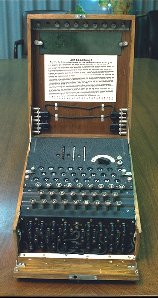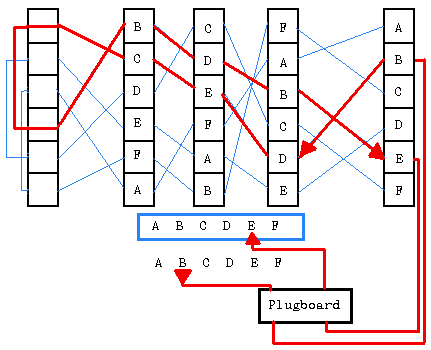The Enigma Code Machine
Written: April 1998
Published: Jun 14, 2008
Author: Drew Ballard
- Last Modified: 24.April.98 *Revision History*
Anyone with any information to add, please email me. I would greatly appreciate your help. I am especially looking for any further information on cyphering/transmission procedures. What is on this page is all I have uncovered so far.
History:
The Enigma machine was developed by the Germans for business communications in the 1920's. Luckily, some Poles working on the machine were smart enough to realize the potential of the device and built their own copies of it. At the time neither France nor Great Britain were interested in it.In the 1930's France began taking a stronger interest. Also at this time, Hans-Thilo Schmidt, a German playboy and employee of the German Army's Cypher Center (Chiffrierstelle) began selling transmissions to the French to help support his expensive lifestyle. In 1934, Herr Schmidt was even appointed to the top secret crypto unit of the German Army (Forschungsamt) by Göring himself. He then began providing the bimonthly keying manuals of the German Army. But the French still had little success in decyphering transmissions.After the invasion of Poland in September 1939, the brilliant Polish mathmeticians who had copies of the Enigma machines emigrated to England and provided the British with enough information to set up Bletchley Park, where the Enigma was decyphered for the rest of the war.Once the British understood the mechanism of the machine and the encyphering methods, they were able to slowly decrypt German transmissions. They were greatly assisted by the wiring details provided by the Poles, the keying manuals provided by Schmidt, and even original manuals and machines captured from German U-33 and weather ships München and Lauenburg. Decyphering was made much easier (yet still extremely difficult) when the war grew nearer and they intercepted many more transmissions per day. They actually knew, weeks ahead of time, of the invasions of Czechloslovakia, Poland, and then France. Through time, the British became so well practiced in decyphering German transmissions, that they were able to receive and decode Erwin Rommel's orders before he even received them. Each time that the Germans changed their machinery or encyphering methods, Bletchley Park took some time to get back up to speed. But due to ingenious decoding machinery and some brilliant minds; they always got back up to speed. During the war, the Germans set up commisions to discover how so much intelligence was reaching the Allies; they always concluded that Enigma was 100% secure and the leaks must be due to spies.
Function:
The machine can be powered internally by a battery, or externally. When a key is pressed, current travels to the entry wheel. This wheel does not turn, it simply has contacts upon which the spring loaded pins of the rightmost rotor ride. The current moves through the entry wheel and then through each one of the rotors; it then enters the reflector and travels back through each one of the rotors. It then goes back through the entry wheel to the lightboard. A character is then lit; this is the encyphered character.The wiring leading to the entry wheel can not be changed. Same with the reflector; although the reflector can be swapped out. This was not done very often.The different reflectors were called B and C.
The rotor wiring is actually internal; the picture was just drawn that way for ease of understanding. One side of the rotor has spring loaded contact pins which ride upon the contacts of the rotor or wheel next to it. The ring containing the letters and thumb wheel is actually separate from the rotor itself. Each day the ring would be positioned on the rotor (Ringstellung) according to the daily key before being inserted into the machine. Thus, with the Ringstellung changed, the electrical path would be different even if the same 3 characters appeared in the windows(Grundstellung). The letter ring also has notches which turn the rotor to its left. After each character is entered, the rightmost rotor turns one position; each consecutive rotor will turn one position for 26 turns of the previous one. Thus, after each turn, the electrical path is completely changed. If one repeatedly typed the character 'A' the output of the machine would continually vary (SHBGDUMNTCJ). It may repeat itself (HBNLIRCHH). But due to the electrical path, the output could never be the original character. This fact helped the British crack the codes. The original machines had only 3 wheels to rearrange for each message. The German Army and Luftwaffe had 5 wheels from which to choose and arrange. The German Navy had 8 wheels from which to choose, and later their machines could use 4 wheels.
The plugboard is used to swap a pair of characters; both input and output. If one plugboard connection is 'AU', when character 'A' is typed, electricity will travel to the plugboard and character 'U' will go to the entry wheel to be encyphered. If the output just happens to be 'A', then the plugboard will change the output to 'U'. But again, since the original character is 'A' the output can never be 'A'. The Germans always made 20 pairings and left 6 characters unplugged; these unplugged characters were called 'self-steckered' from the German word for plug (stecker).
Differences-The Abwehr (German Army Intell.) machines did not have a plugboard, but the wiring to the entry wheel and the reflector itself, could both be changed. The reflector also turned. And most difficult for the British, their wheels did not have just one 'turn over' point, they had 11, 15 and 19. While at first this was impossible for the British, it later helped in the fact that once in a while all four wheels would turn at once; creating patterns in the encyphered text. At the beginning of the war, the German Navy Enigma was a 3 rotor machine but they had 8 rotors to choose from. Later, they also came up with a changeable reflector.
Encyphering/Decyphering/Transmissions Procedures
- Luftwaffe/Heer
Glossary:
Abwehr-secret intelligence service of the German High Command(OKW)
bombe-British electro-mechanical machine used to discover wheel settings of the Enigma keys
Chiffrierstelle-German Army's Cypher Center
Code-a system of substituting multiple characters or numbers for the parts of a message. ie. The Fallschirmjägers have arrived in England. ---> "The Eagle has landed"
Cypher(Encryption)-a system (other than a code) of substituting characters or numbers for the characters of a message. ie. HELLO...BOB ---> ....IFMMP...CPC
Forschungsamt-top secret crypto unit of the German Army
GC&CS-Government Code & Cypher School, British cover name for Bletchley Park
Grundstellung-characters that the rotors are turned to, to start encyphering (ground/starting position)
Heer-German Army
Kenngruppe-discriminant,one of four 3 letter groups used on a particular day to specify key
Key-1.A setup used in common by a particular group. 2.The actual setup for a particular day.
Magic-US cover name equivalent to 'Ultra' but also covered Japanese signals
Ringstellung-position of the letter ring on the rotor prior to installation in machine(ring position)
Sicherheitdienst-Intelligence service of the SS
Stecker-Plug
Ultra-British code name for all high level German transmissions, not just Enigma
Umkerwalze-reversing wheel (reflektor)
Walzenlage-wheel order
Red-general key of the Luftwaffe
Yellow-Heer/Luftwaffe key, used only in Norway
Brown-key used by Kampfgruppe 100, responsible for bombing raids on England
The German Expeditionary Force in Africa had its own keys which the British named after birds. One of the most important was Chaffinch.
Light Blue-Luftwaffe key used in Africa
Links:
- Enigma
- Enigma Program
- Enigma Exhibit - Chicago Museum of Science and Industry. This is the Enigma from U-boat 505.
- Enigma Exhibit - National Security Agency
- Bletchley Park - The top secret location where the British decyphered Enigma
- U-boat Net - For Enigma, follow technologies link. Very good info
- Codes and Cyphers
- National Security Agency - Has a real nice National Cryptologic Museum Tour
- MAW 97 (Math Dept ASU) -
- American Cryptogram Association Has LANAKI course, all papers, programs, and 4 addt'l 1997 lectures.
- Classical Cryptography Course-Lanaki Very attractive site, lots of pizzazz
- Sources:
- *Code Breakers-The inside story of Bletchly Park Sir F.H.Hinsley and Alan Stripp, Oxford University Press 1993
- The Unseen War in Europe John H. Waller, Random House, New York 1996
- Seizing the Enigma-The race to break the German U-boat codes 1939-1943 David Kahn, Houghton Mifflin 1991
- **The Hut Six Story Gordon Welchman McGraw-Hill 1982
- The ICSA Guide to Cryptography Randy Nichols, McGraw Hill Prof. Books 1998, 840pp $70,[ISBN 0079137598]
Classical Cryptography Course Randy Nichols, Aegean Park Press 1998, Vol. I 301pp $34.80 [ISBN 0894122630] and Vol. II 452pp $40.80, [ISBN=0894122649]- All internal photos are © and the courtesy of Morton Schwimmer.
90th IDPG Articles



